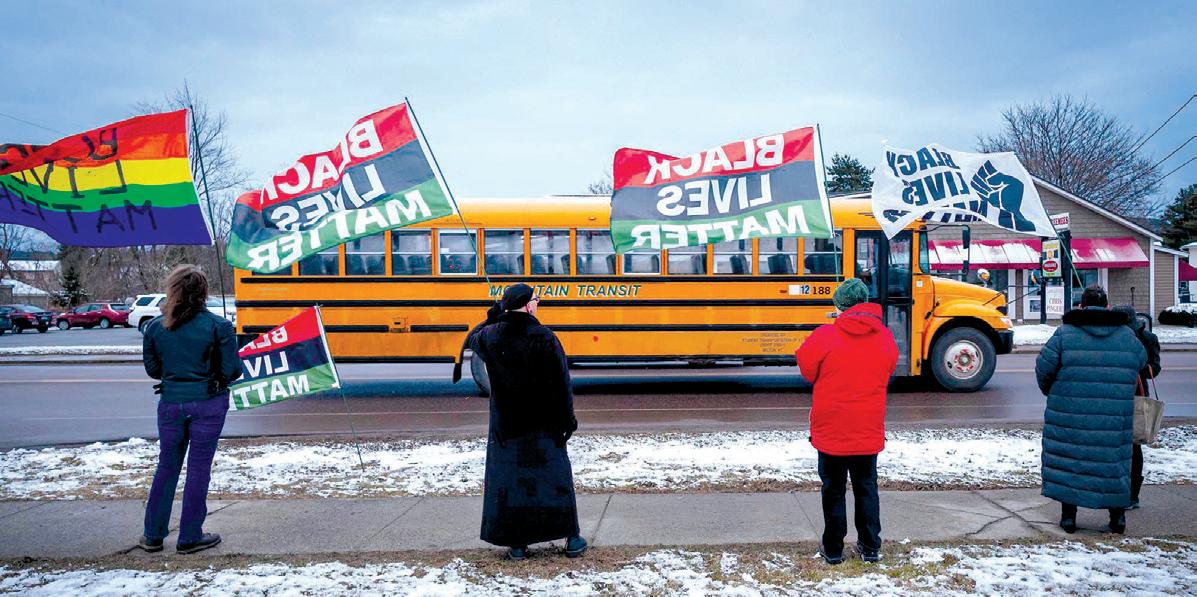Housing developments receive final allocations





A $2.7 million budget deficit looms over Green Mountain Transit that, if not solved by November, will have leaders of the region’s public transit provider looking to eliminate about 30 percent of local bus service.
In a Monday meeting, GMT’s General Manager Clayton Clark and Finance Director Nick Foss explained to a group of municipal administrators and state legislators that the organization has plugged its fiscal hole with federal pandemic relief grants for the past three years. After the upcoming fiscal year, which begins in July, those funds will run dry.
“Our covid relief funds will be totally exhausted by 2025,” Foss said, estimating that the organization’s covid relief grants have totaled $16 million.
Despite a pandemic-era decision to stop collecting fares from riders (fare collection is set to resume this spring), ridership has dropped in recent years. According to GMT’s count, ridership dipped as low as 60 percent of pre-pandemic levels in 2021 before rebounding to 85 percent of pre-pandemic levels in 2023.
On its commuter buses from Burlington to Montpelier and Burlington to St. Albans, ridership is about half of what it was pre-pandemic, Foss said. The route between Williston and Burlington remains the organization’s best performing route with about 1,500 riders a day.
GMT leaders expect a resumption of fare collections will bolster the budget; they hope it will eventually account for about 10 percent of GMT’s annual revenue. But pre-pandemic, fare collections made up as much as 20 percent of the organization’s revenue. The bulk of GMT’s revenue comes

Two of the larger housing developments to be proposed in Willison’s recent history received their full complement of Growth Management allocation Tuesday at a Development Review Board meeting.
The DRB meets annually in March to consider requests for housing construction under a growth-limiting cap outlined in the town’s land use regulations. The cap limits housing allocations to 80 units a year. On Tuesday, the DRB awarded 35 units to Snyder Homes’ “Annex” development on the former Essex Alliance Church property off Route 2A north of Taft Corners. That adds to previous allocations granted in 2022 and 2023 to give the neighborhood its full ask of
276 homes in a mixture of duplexes, single family homes, apartments and senior living units.
The DRB then awarded 24 units to “Summer Field” — the neighborhood set to be built by developer Chris Senesac on a 30-acre portion of what is currently the Catamount Country Club golf course on Mountain View Road. The project received the majority of its 141-unit request during prior year Growth Management meetings.
“It’s good to have that finally over,” Senesac said of the Growth Management process. “We’ve been through it four times … It’s an important part of the approval process.”
This is likely to be the final season of play on the nine-hole Catamount golf course, as Senesac is eyeing a groundbreaking this fall. Golf course owner Alex Kourebanas has said he intends to keep a

from federal, state and municipal contributions. The Town of Williston, for example, contributes roughly $280,000 annually — the fourth biggest contributor in Chittenden County behind Burlington, South Burlington and Essex, according to Foss.
GMT is lobbying for a recurring state-level funding source to stabilize its finances into
the future.
“This is a problem that a majority of transit agencies are facing right now,” said General Manager Clark. “It’s an industry-wide problem.”
Sen. Thomas Chittenden, who represents Williston in the Chittenden Southeast Senate


Annual dog licenses, required for all dogs over 4 months old, can be obtained at the Williston Town Clerks Office at 7900 Williston Rd., Monday through Friday, 8 a.m. to 4:30 p.m. Licenses can also be renewed by mail or using the drop box behind Town Hall.
Owners must provide proof of rabies vaccination. The fee is $13 for dogs that are spayed or neutered or $17 if not. Questions can be emailed to Town Clerk Sarah Mason at smason@willistonvt.org.

Scott Rogers and family
Williston resident Scott Rogers, a member of the Williston
Housing Committee, has been hired as director of development and communications for Green Mountain Habitat for Humanity.
Rogers will manage the external affairs of the Williston-based nonprofit, including fundraising, grant-writing and communication strategy, overseeing a team of three people.
“Scott is already engaged in the affordable housing efforts in his community, and we are excited to see how he can bring his talents to this position,” said Habitat CEO David Mullin.
Rogers formerly worked in the City of Burlington’s Community and Economic Development Office.
“I am eager to make a meaningful impact,” he said. “I’m thrilled to collaborate with the team at Green Mountain Habitat for Humanity to amplify their

efforts in building homes and extending support to more individuals and families in need within the community.”
Green Mountain Habitat for Humanity is a non-profit homebuilder that partners with donors, local families and volunteers to build and sell affordable homes in Chittenden, Franklin, Grand Isle and Lamoille counties. Habitat homebuyers help build their homes alongside community volunteers and pay an affordable mortgage.
Since its founding in 1984, the affiliate has built over 115 homes in the region and now operates three Habitat ReStores in Williston, Milton and Swanton.
To learn more, visit vermonthabitat.org. Habitat for Humanity has affiliates in all 50 states and 70 countries.
In an Around Town item in last week’s edition of the Observer, the recipient of $1.2 million in state and federal stormwater infrastructure grants was misidentified as the Williston Woods Homeowners Association. The funds in fact have been awarded to the Williston Woods Cooperative Housing Corporation.
The corporation was formed as Phase II of the Williston Woods neighborhood with a separate governing structure, while the Williston Woods Homeowners Association represents Phase I of the neighborhood.





 PHOTO BY GLENN RUSSELL/VTDIGGER
PHOTO BY GLENN RUSSELL/VTDIGGER
On a brisk Wednesday morning, a group of bundled-up residents waved a wide array of Black Lives Matter flags by the road leading to Milton High School.
“When you can’t say three words that are positive without thinking it’s negative … that’s racism,” said
Ember Nova Quinn, a Milton parent and former district employee who carried a Black Lives Matter flag that sported the red, black and green colors of the Pan-African flag.
By 7:15 a.m., eight people had gathered on the snow-lined sidewalk. They were there to protest the Milton Town School District Board of Trustees’ recent decision to rewrite the district’s flag policy and take down the BLM flag.
The previous policy, adopted see FLAG page 9
Vermont Attorney General Charity Clark, a resident of Williston, is running for a second term as the state’s top prosecutor.
Clark announced her reelection bid on Monday morning at a press conference in downtown Winooski. Speaking from a podium outside of the Champlain Mill building, Clark emphasized what she said was a record of protecting Vermonters while in office, including her role in state lawsuits against mega-corporations such as Meta and Monsanto.
“I am proud of what we have been able to accomplish in just over a year,” Clark said. “My work, however, is not done. I am running for reelection to continue what we started on these lawsuits and initiatives.”
Clark also positioned herself as a buffer against a potential second Trump presidency, saying


she would safeguard Vermonters from any decisions the presumptive Republican nominee might make against Vermonters’ interests if he returns to office next year.
“I will fight to make sure Vermont’s voice is heard and to counter any immoral, illegal or unjust action taken by Donald Trump,” she said.
Clark, a Democrat, first took office last January after winning


a landslide victory against Republican Mike Tagliavia. Previously, she had been an assistant attorney general in Vermont for over eight years, four of which she spent as the office’s chief of staff.
Clark is the first person to enter the race from any party. If she faces a primary challenger, they would square off on Aug. 13 before the general election in November.









Have a warmer home with community-built window inserts
BY MELINDA SCOTT Williston Energy and Community Development PlannerAre the windows in your home drafty? Are you tired of the cold and discomfort every winter? If you need to stop the drafts in your home, while improving your comfort and reducing heating costs, WindowDressers insulating window inserts can help.
WindowDressers insulating window inserts fit inside of your existing windows, letting in sunlight and views while keeping more heat inside your home. The inserts are high quality and low cost because they are built at barnraising-style community builds across Maine, Vermont and New Hampshire.
WindowDressers, a non-profit
organization, has run a very successful program since 2010, which has helped citizen-based teams provide over 68,000 window inserts to thousands of homes in northern New England, saving residents an estimated $1.9 million in heating costs.
Far superior to shrink-wrap plastic window covers and much less costly than replacement windows, wood-framed window inserts are custom measured and built to exactly fit into the inside of your window casings. The inserts are built of attractive pine frames and wrapped drum-tight with two layers of durable plastic film. The two layers of plastic create an insulating air space while letting in all the light and views.
Foam weather stripping around the outer edges stops drafts and ensures the insert’s tight, custom fit.
The inserts are installed on the

inside of windows and held in place by friction. Depending on the efficiency of your windows and home, you could see fuel savings of up to 20 percent with inserts in place.
The inserts can be removed at the end of winter and reinstalled each fall. With care, the inserts should last for 10 years. Should the plastic covering be damaged, it
can be repaired for a modest price without replacing the frame.
Window inserts work with most double hung, sliding and casement windows. Your existing window frames must have square corners and a minimum of 7/8-inch of interior framing (“the jamb”) available for the insert.
The inserts may not work
in manufactured/mobile homes because of the limited framing around the windows.
As each insert is custom built for your home, costs are dependent on the size of the window.
WindowDressers estimates the





The arrival of spring gets many of us in a home cleaning mood. This spring, consider using cleaning products that are safer for you, your family and the environment.
The EPA has developed the Safer Choice label to identify products that are certified to contain safer chemical ingredients while still performing well.
If a product carries the Safer Choice label, it means that the EPA has reviewed all of its chemical ingredients, regardless of their percentage in the product, against strict safety criteria for human health and the environment, and judged them to be safer than alternatives. Additionally, products must perform comparably to conventional products

on category specific standards.
To earn the label, manufacturers are also required to implement sustainable packaging measures and to improve the packaging profile for their products. To learn more about the Safer Choice program and find certified products, visit www. epa.gov/saferchoice.
continued from page 4
cost to be from $35 for a small window to $65 or more for a large window. If cost is prohibitive to you, WindowDressers has a program to provide windows at a reduced or even at zero cost.
You don’t need to obtain all your inserts in one year. Many people obtain a few and add more each year. Renters as well as homeowners are eligible for the WindowDressers program. Information is available to share with landlords about the program and the inserts.
A big reason these inserts are so affordable is that you are only charged for materials. Community volunteers are key to the success of the program. Everyone who orders inserts also participates in the community build. Participation is part of the cost of getting inserts and it’s a lot of fun.
All community members, whether purchasing inserts or

not, are invited to participate in any of the many tasks, including project coordination, window measurement, procurement, construction and installation.
During a community build event held over several days in the fall, participants are asked to contribute a four-hour shift for every 3-5 windows requested. All
Everyone who orders inserts also participates in the community build. Participation is part of the cost of getting inserts and it’s a lot of fun.
tools, supplies and training are provided and there are a range of tasks so there are ways everyone can help. Plus, participating in the community build event is fun and a great way to meet new people in your community. It literally builds community.
Your local WindowDressers volunteer team is accepting orders now for the fall 2024 community build season. Once you sign up, trained volunteers will schedule a time to measure your windows for the custom-built inserts. Then in the fall, you and other community volunteers will gather to build the inserts. Following the community build, you are responsible for transporting your window inserts home and installing them and beginning to enjoy a more comfortable home while reducing your heating costs.
To learn more and sign up for window inserts, visit www.windowdressers.org. Email burlingtonwindowdressers@gmail.com with any questions.
To participate in Williston’s energy future, reach out to your Williston Energy Committee at energy@willistonvt.org or attend a public meeting held on the second and fourth Wednesday of each month. The agenda for upcoming meetings is posted on the Town of Williston website (www.town.williston.vt.us). For more information, visit: https://www.willistonvtenergycommittee.org.



The Wall Street Journal recently reported that “roughly half of college graduates end up in jobs where their degrees aren’t needed,” raising uncomfortable questions about the value of a college education.
The report is part of a drumbeat of headlines focused on declining student enrollments, budget deficits and changing academic programs — reflecting dramatic shifts in the higher education landscape.
If you are an Ivy League university with a $50 billion endowment, it can be business as usual, but the majority of the nation’s 3,900 higher education institutions need to evolve.
At Champlain College, we are asking: What does the college of the future look like?
If we want students to succeed in a strong first job after graduation — and realize the long-term promise of a college education — we must design institutions that give students the experiences they need to launch their careers and live meaningful lives.
The college of the future will
break down the classroom walls so students can learn in the workplace, the community and around the globe.
Through deeper partnerships with employers, students can earn academic credit and a paycheck. We can turn higher education upside-down and give students career-focused experiences the moment they start college — experiences that build confidence, humility and curiosity.
For example, Champlain College recently announced a partnership with NuHarbor Security, a leading cybersecurity firm, to open a NuHarbor office on our Lakeside Campus in Burlington’s South End Innovation District. Beginning their first year, students will learn from faculty and industry professionals in the same space, take on paid internships and manage their own cybersecurity business.
This unconventional approach drives results: Our cybersecurity graduates have a 97 percent employment rate and an average starting salary of $70,000 in a fast-growing industry.
However, meaningful work is about more than just a paycheck.
We need to set students up for longterm fulfillment and success.
The college of the future will reach across disciplines and let students combine their interests so they can be future ready.
Breakthrough technologies like artificial intelligence, digital bi-
We can turn higher education upsidedown and give students careerfocused experiences the moment they start college.
ology and sustainable energy are reshaping the world. Students can specialize to advance these breakthroughs, but, for every specialist we educate, we need many more students who can connect the dots across fields and help us interpret and adapt to the changes these technologies bring.
At Champlain College, we imagine a team of students majoring in psychology, computer sci-
ence, creative media and criminal justice working with the State of Vermont to combat the fentanyl crisis. In the future, students from different majors will share more courses and experiences to better understand the forces shaping our world. This is how students learn to collaborate, build products and services and tackle social challenges.
Imagine an entrepreneurship student interning for a sustainable food startup, combining their interests in biology and marketing to help the company launch its product. In the future, students will have more flexibility to customize their education to pursue emerging opportunities.
The college of the future will help students be more human in a digital world.
Being future ready is not simply about knowledge and technical skills. As technology does more and more, it is our humanity that sets us apart. What values guide our choices and actions? How do we form enduring relationships? How do we communicate to build trust and inspire action? Higher education has always been good at
exploring questions that encourage students to grow as human beings.
Colleges will build on students’ human strengths, cultivating mindsets and behaviors that lead to connection, creativity, inspiration and achievement.
In the end, employers can teach technical skills, which constantly change. What they tell us they value most are employees with the personal and professional competencies to help diverse groups of people thrive — in the workplace, at home and in the community.
Higher education is at a crossroads. Changing demographics, economics and technology are forcing colleges to evolve. These same factors are impacting Vermont in profound ways.
At Champlain College, we are building the college of the future so students are ready to launch their lives. We are building the college of the future because Vermont needs innovative, dynamic education institutions acting as engines of opportunity. It is time to transform.
Alex Hernandez is the president of Champlain College in Burlington.

that we can verify the letter’s author.



In 2021, Vermont ranked 16th in the nation in median household income, according to U.S. News and World Report. According to the U.S. Census Bureau, we ranked third that year in the nation in spending per pupil.
That was before the increases of this year. The state Legislature insists on driving this gap wider and wider every year. It is unsustainable.
The 2021 figure of $23,586 spent per pupil per year is enough. Plenty of private schools operate on tuition only, charging $10,000 per year less. We need to stop pretending like it is necessary to drive the price higher. Stop pretending that all these things are necessary to pay for. We are driving our older generation out of the state with

the careless tax increases.
What is fair? What is equitable? What is realistic? Let’s put some math-based limits in place.
Education funding increases should not go up at a rate higher than median income. For example, if the Vermonter in the middle makes 6 percent more than she did last year, she should be stuck with no more than a 6 percent increase in education taxes. We are already charging taxpayers enough. We need to make some hard, either/or choices and cut spending.
Why are schools providing social services? Schools are not here to take the responsibility of parents. Increasing social services is simply not an education issue.
Mental health is a health issue.
It is inappropriate to saddle taxpayers with Health and Human Services expenses in the school budget.
Our state leaders in education need to reset their focus on teaching. Equality is about giving everyone an opportunity. Not every student is going to make the most out of the opportunities they get. The excessive level of counseling services from the covid era is not sustainable, and the taxpayers of Vermont are not convinced it is central to the mission of teaching children.
What Vermonters are saying: Education is important, but it is not worth a larger percentage of their income than it was last year. With inflation in the past two years, Vermonters feel the squeeze on all parts of the household budget and the appetite for the increase in taxes simply is not there. It’s time to make cuts.
David Martel Williston








We can put the ways forests benefit our quality of life into three categories: ecological, economic and cultural.
The ecological benefits include how forests clean our air and water, regulate our climate and provide the means for humans, and so many other species, to exist. Forests also provide economic benefits, including growing local, renewable resources like wood that enrich our lives and lower our reliance on more harmful resources produced elsewhere. Finally, forests provide cultural benefits. They are essential to our identities as Vermonters and to so many of the things that we do, value and love.
As we vision a future for ourselves and our forests, balancing all of these benefits is key. How can we care for forests in a way that creates and sustains an ecologically, economically and culturally functional landscape?

Forests can be placed into one of three broad categories: production forests, working forests and reserves. These categories call for different forest management approaches and objectives with strategies that have different strengths and weaknesses.
In production forests, trees are managed essentially as crops, often grown and harvested on relatively short rotations and using intensive management techniques. Production forests may be more diverse forests of naturally regenerating trees, but they often take the form of

monoculture plantations.
Production forests provide some of the ecological benefits of a natural forest, but their main strengths are economic. They provide huge amounts of renewable resources, jobs and local economic benefits. It should also be said that the fact that production forests produce so many renewable resources is itself a powerful global ecological and cultural benefit, lowering our reliance on resources that cause significant harm to ecosystems and people.
The category that nearly all forests in Vermont fall into is working forests. These are forests that are periodically managed for wood and other resources, but also for a wide range of other values, like biodiversity protection, carbon, wildlife habitat and recreation. The economic benefits of working forests are not as concentrated as production forests, but they provide periodic economic benefits, as well as more ecological and cultural benefits than production forests.
Finally, forest reserves are forests that are essentially un -
managed, allowed to develop largely without human intervention. Reserves may provide some economic benefits from tourism and forest-based recreation, but their primary benefits are ecological and cultural.
While you may be biased toward one type of forest or another, production forests, working forests and reserves are likely all necessary to meet our ecological, economic and cultural needs. They exist in a dynamic relationship with one another. If we want more reserves, we will also need more production forests to produce the resources that we need to sustain us; if we want fewer production forests, we will need far more working forests and fewer reserves. If we say “not in my backyard” to working forests in Vermont, we are likely saying “yes” to production forests somewhere else.
Of these three forest types, I think that working forests are by far the most radical and beneficial. They are the only forests that we have a real relationship with, the only ones that truly balance all the things that we ask, and require, from our forests.
In working forests, we can recognize our responsibility to protect forests for their own sake (like a reserve), and to produce renewable resources (like a production forest), while also acknowledging that we can play a positive and even regenerative role in these ecosystems — not as a farmer of a crop, not as a bystander, but as the steward of a complex and precious living system.
While we need some production forests and reserves, I believe that working forests are the place where we can maximize the ecological, economic and cultural values of forests.
Ethan Tapper is the Chittenden County Forester for the Vermont Department of Forests, Parks and Recreation. For more, visit https://linktr. ee/ChittendenCountyForester.
continued from page 3
in August 2019 at the urging of student activists, is slated to be replaced with a new policy that states, “The only flags displayed shall be the United States of America and the State of Vermont flags.”
Dev Welch waved a rainbow BLM flag outside on Wednesday.
“I’m here to support students and show them their decision matters,” she said.
The five-member board reversed the district’s policy with a unanimous voice vote at its March 14 meeting. None of the members responded to requests for comment last week, and there was almost no discussion before they took the vote.
“The only flags displayed shall be the United States of America and the State of Vermont flags.”
Proposed Milton Town School District policy
At the meeting, Scott O’Brien, a newly elected school board member, did call for some time, perhaps a week, to reflect before the flag comes down.
“While it is policy right now, the BLM flag that’s up there meant a lot to a lot of people in the community, so if we could push it out … It doesn’t have to come down immediately,” he said.
In reality, it will take at least a little longer.
A policy change must be warned for 10 days and face another board vote before taking effect, according to Superintendent Amy Rex. That might not happen until the board’s April 11 meeting.
Heather Preuss is among parents who have sent emails to the board alleging the new flag policy conflicts with at least six school board, district and state policies pertaining to equity and ethics.
The lone flagpole is not visible from the main road. It stands outside the high school building entrance at the end of a long entry road. As of last week, the BLM flag was still there, flying under larger U.S. and Vermont flags.
Voting to take down the flag was one of the first actions the district’s new school board took upon being seated — and the protest-


ers, several of whom are queer or non-binary, saw it as an ominous sign.
Milton had several competitive races for school board seats this month, and more than 23 percent of voters came out to the polls on Town Meeting Day — the highest turnout since 2017, according to the town clerk.
Incumbent Karen Stout narrowly won reelection. And after making previous unsuccessful bids, both Allison Duquette and Scott O’Brien won seats. They joined Jeremy Metcalf and Kumulia Long, who were not up for reelection this year.
Several members of the community and former students have voiced concerns that the new board members could take further steps to undermine the district’s equity work.
They’ve pointed, in particular, to two members who have opposed the district’s equity policy and, in past races, have been endorsed by a group called Vermont Parents Against Critical Theory. The group’s website, which doesn’t list any staff names or organizational structure, contains anti-equity material as well as anti-trans content and articles critical of antiracism theory. Front Porch Forum blocked its posts last year, the group has claimed.
At the March 14 meeting, James Provost, a parent of two students, called for Duquette and O’Brien to either formally distance themselves from Vermont Parents Against Critical Theory or step down from the school board.
Residents from neighboring towns have also expressed concern





continued from page 9
about the Milton board. Johnny Chagnon, of Georgia, was among those protesting outside the school. With demographics changing, the region needs to embrace cultural diversity, he said.
“This current school board equals death to Milton’s growth, death to efforts to address racism within Milton High School, and death to preparing our students to be competitive in a highly diverse and global economy,” Chagnon later wrote.
Those protesting on Wednesday said the flag decision was particularly upsetting because it took place amid what they characterized as an increase in attacks against marginalized people in Milton. Quinn, for example, is transgender and ran for school trustee this year, but dropped out of the race citing threats that made them fear for their safety.
The decision to fly the Black Lives Matter flag was the product of a two-year effort led by the Milton Students for Social Justice group.
The group formed in 2017 and two years later petitioned the school board to fly the BLM flag, which led the board to create the first flag policy, according to Pete Wyndorff, a teacher at the high school who serves as a faculty advisor to the group.
The move reflected growing nationwide support for the Black Lives Matter flag as a symbol to address white supremacy and racism in places like schools, he said.
Mariam Pakbaz, a 2021 graduate of Milton High, was among the students involved. She called the
board’s recent vote to remove the flag “heartbreaking.”
Raising the flag in Milton symbolized unification, solidarity and the community taking a stance against all types of racism, Pakbaz said.
“It was important for me because I’m a woman of color and I had always felt pretty marginalized in my own community,” she said, adding that she faced “a lot of microaggressions and a lot of racist behavior” growing up in the Chittenden County town of about 10,500.
Lydia Beaulieu, who graduated from Milton High School in 2023, said she attended multiple gatherings in support of raising the flag and participated in the protests that followed when it was stolen and vandalized.
“A flag is representative of a larger movement, and that movement will not cease because its symbol is gone,” she said in a written statement.
Addie Lentzner, founder and co-executive director of the Vermont Student Anti-Racism Network, made a similar point.
“It’s about more than a flag. It’s about a commitment to work to dismantle systemic racism,” she said. “If a school isn’t willing to put up a flag, will they be willing to commit to do the work?”
As the protesters waved their flags on Wednesday, some cars honked in support. A woman in a passing car slowed, rolled down the window and gave them a thumbs up, her breath clouding up in the frosty air.
“I didn’t hear what she said,” said one of the flag-holders.
“I don’t know, but I saw a thumbs-up,” said another. “I’ll take that.”

continued from page 1
driving range and three holes open for play, as well as the clubhouse for events, alongside the Summer Field neighborhood. Senesac said the project is still under Act 250 land use review with the State of Vermont.
“We are hoping to be at a point where we can start relatively soon,” Senesac said. “It’s been a long process and we’re looking forward to getting going.”
Snyder Homes has already broken ground at The Annex. Just northeast of the Vermont State
continued from page 1
District and serves on the Senate Transportation Committee, said sustainable transit funding could come from a new tax on electric vehicle charging. With about 12,000 electric vehicles on the road in Vermont, he said, that tax could bring in about $3 million annually — mimicking the gas tax that gas motorists pay. A study commissioned by GMT identified other potential sources of recurring revenue for public transportation, such as a fee on car registrations, a tax on car rentals, a fee on utility bills and a fee on online shopping deliveries.
“I really like the idea of car
Employees Credit Union on Route 2A, Blevins Excavating is clearing way on portions of the 54-acre parcel for water lines, sewer lines and utilities. Phase one of construction will include 85 homes and two apartment buildings, Snyder Homes owner Chris Snyder said.
Phase two construction will include a public park with outdoor art displays and natural play elements, and provide a connection into Williston for the rec path from Essex Junction that currently dead-ends at the north end of the property at Beaudry Lane.
Also Tuesday, the DRB granted a conversion of three
“I really like the idea of car registration fees subsidizing public transit.”
Sen. Thomas Chittenden
registration fees subsidizing public transit,” Chittenden said. Absent a new state revenue source, GMT administrators will begin the process of eliminating routes in November, Clark said, as a cost-saving measure for the fiscal year 2026 budget. They’ll work with GMT’s volunteer board of commissioners to set criteria
housing units at the 10-acre Michaud parcel on Mountain View Road across from Trinity Baptist Church to market-rate units. The units were previously approved as deed-restricted affordable units. The conversion will require the developer, Scott Michaud, to pay $49,000 into the town’s Affordable Housing Trust Fund in accordance with inclusionary zoning rules adopted by the selectboard earlier this year. The trust fund aims to facilitate future affordable housing projects in town.
The Michaud project calls for 15 homes. With Tuesday’s approval, the project is fully allocated.
for which routes to cut and take public comment before finalizing decisions.
Meanwhile, when fares do resume this spring, they will come back at $2 a ride, an increase of 50 cents from pre-pandemic fares. Half-price fares will be offered to riders under 18 and over 60, and daily and monthly caps will keep expenses predictable for frequent users.
The resumption of fares was originally planned for January but has been delayed as GMT awaits a contractor’s completion of a smartphone app that will allow riders to pay online. GMT will also sell pass cards that can be preloaded and scanned on the bus. Cash will continue to be accepted.

Two jobs legislators want created as part of a bill to standardize restorative justice referrals in Vermont may not be guaranteed, which could make the rollout of the bill harder.
Lawmakers, since January, have been tinkering with H.645, which would codify the practice of precharge referrals so the process is the same regardless of county. The bill also aims to create a standard for funding the state’s restorative justice centers, which sponsors say is inconsistent and disorganized. The bill passed the House mid-March and is now in the Senate judiciary committee.
Legislators added provisions to the bill to create two positions: a director of policy within the Vermont Department of State’s Attorneys and Sheriffs and a diversion program coordinator for the Office of the Attorney General. The two positions combined would cost $277,000, according to the Vermont Legislative Joint Fiscal Office. Under legislators’ original revision, that money would come from general fund ap-
propriations for next fiscal year.
But when the bill went to the House appropriations committee, it came back with amendments that would create those two positions only “to the extent funds are available.”
“It’s a way to allow the bill to move forward even though we aren’t certain that the positions are going to be established and fully funded,” said sponsor Rep. Karen Dolan, D-Essex Junction, who works for the Essex Community Justice Center.
“The positions got scaled back because there is great concern about how much money it would total to fund all the requests for FY 25, between the budget and bills that have funding requests in them,” another sponsor, Rep. Barbara Rachelson, D-Burlington, said in an email.
Without those positions guaranteed, “it will likely just be a much slower starting process than if they had the positions to get things moving,” Dolan said.
The diversion program coordinator would manage the new precharge referral system established in the bill.
Under the bill, restorative justice
centers in each county would be required to have a policy on how they handle pre-charge referrals before cases can be diverted to them. The Department of State’s Attorneys and Sheriffs policy director position would help implement those policies to get the new referral process up and running.
“It probably wouldn’t progress at the same speed as if we’d had the positions in place,” Dolan said.
Senate judiciary committee members are scheduled to discuss the bill during their March 29 meeting.
Restorative justice center leaders say the bill would help clear backlogged referrals — when a prosecutor sends a case to a rehabilitation program rather than filing charges in court. That process already exists in Vermont, but there’s no standard for how it’s done.
“It’s not necessarily doing anything to reinvent restorative justice or restorative approaches; it is making it so it is more streamlined access across the state,” Dolan said in a past interview with Community News Service. “This is trying to get some consistency and also respect
the uniqueness of each county.”
For supporters, the goal is to define expectations so state’s attorneys and law enforcement feel confident their referrals will be processed the same way no matter which county they are in.
The Community News Service is a program in which University of Vermont students work with professional editors to provide material for local news outlets at no cost.

When Vermont lawmakers last tinkered with education funding earlier this session, the president of the Senate called for “groundbreaking” new ways to contain costs.
Thus far, such radical reimaginings are yet to materialize. But they may be coming.
Rep. Emilie Kornheiser, D-Brattleboro, chair of the House’s tax-writing Ways and Means Committee, said that lawmakers this week are likely to discuss possible changes to the state’s education funding formula. But those conversations, she said, are likely to start broad.
“I don’t have a secret plan that I’m waiting to unveil,” she said.
Nevertheless, ideas are floating around, both in the building and across the country.
“I think there are a lot of really good ideas from other states that we’re going to talk through. But I don’t think anyone has anything that’s fully baked, because this is all really complex,” Kornheiser said, “and it needs to be a collaboration with districts who are the ones who are making these tough budgeting decisions.”
A change to the education funding formula could appear in the yield bill, the annual piece of legislation that begins in the House and helps set education property tax rates statewide.
Altering the state’s funding formula, Kornheiser said, would require balancing two pervasive and competing messages education leaders have repeatedly sent lawmakers this year: one, big change is needed now. And two, don’t rush into making changes that could upend an education system already in crisis.
Nationwide, the most common way to fund education is a “foundation formula” or “foundation grant.” Simply put, most foundation formulas ensure each district receives a certain

minimum amount of money per student. New Hampshire and New York are among the states that use a student-based foundation, according to the Education Commission of the States.
Kornheiser called a foundation model “the most obvious possibility.”
“There’s certainly a lot of people who are calling for it,” she said. “It solves many of the problems that people have expressed, and a lot would need to be resolved to make that work in Vermont.”
Lawmakers and school officials alike have said that education, and education finance, are at a crossroads.
Vermont’s schools, the country’s second oldest, require billions in construction costs. Increasing mental health and behavioral needs of Vermont’s students, coupled with disappearing federal dollars that paid for specialists, add to the financial burden. So too does the skyrocketing cost of health insurance.
Voters on Town Meeting Day grappled with school budgets projected to raise education property taxes an average of 19 percent, and rejected a historic proportion of them.
Gov. Phil Scott, meanwhile, has suggested that the state’s education funding system may have reached the end of its useful life and has prodded the Legislature to make structural changes by the end of the session.
Amid that fixation on finances, lawmakers also want to tread carefully. Schools’ and the public’s attention on the Ways and Means Committee is intense. Kornheiser said she knows that every time the committee considers hypothetical new proposals or runs new tax projections, those ideas have ripple effects statewide.
“School districts are incredibly stressed,” Kornheiser said, “and I don’t want to add more stress to their plate.”

March 12 at 12:35 p.m. — Retail theft reported at Hannaford. Female was issued a citation to appear in court for retail theft.
March 12 at 5:57 p.m. — Retail theft reported at Ulta Beauty. Arrest warrant issued for male suspect.
March 13 at 1:22 p.m. — Motor vehicle crash on St. George Road. Male operator was issued a citation to appear in court for suspicion of DUI.
March 13 at 9:51 p.m. — Following a traffic stop, a female was taken into custody for active arrest warrants from out of state. She was lodged at the correctional facility.
March 14 at 7:21 a.m. — Stolen vehicle reported on Industrial Avenue. Vehicle was located later that evening by South Burlington Police.
March 14 at 2:24p.m. — Report of a male driving all over the road on North Williston Road. Officers made contact, male was fine.
March 15 at 11:02 a.m. — Retail theft reported at Best Buy. Suspect vehicle was located and seized pending search warrant. Stolen merchandise and drugs located in the vehicle.
March 15 at 12:21 p.m. — Report of male and female in Dick’s Sporting Goods acting suspicious. Male flashed a weapon at an employee. Male and female paid for items and left the store.
March 15 at 9:05 p.m. — Report of catalytic converters stolen out of trucks on Williston Road.
March 15 at 9:11 p.m. — Assisted Wil -


liston Fire Department with power lines down on River Cove Road. Green Mountain Power arrived on scene a short time later to fix the power lines.
March 16 at 10:24 a.m. — Retail theft reported at Best Buy. Female was issued a citation to appear in court for retail theft.
March 16 at 2:34 p.m. — Assisted Williston Fire Department with unresponsive male. Male became conscious and was transported to the hospital for evaluation.
March 16 at 8:06 p.m. — Report of a male missing from Zephyr Road. Male was located intoxicated in his apartment. He was transported to the hospital for evaluation.
March 16 at 11:15 p.m. — Following a traffic stop, a male was issued a citation to appear in court for suspicion of DUI.
March 17 at 8:40 a.m. — Death investigation conducted. Nothing suspicious.
March 17 at 2:31 p.m. — Retail theft reported at Best Buy. Arrest warrant was issued for female suspect.
March 18 at 1:56 a.m. — Following a traffic stop, a male was issued a citation to appear in court for suspicion of DUI.
March 18 at 3:10 p.m. — Retail theft reported at Plato’s Closet. Case is still under investigation.
Officers also conducted 36 traffic stops and responded to nine alarm activations and nine motor vehicle crashes during this time frame.




DOROTHY ALLING MEMORIAL LIBRARY HOURS:
• Monday and Wednesday: 10 a.m.-8 p.m.
• Tuesday, Thursday, Friday: 10 a.m.-6 p.m.
• Saturday: 10 a.m.-3 p.m.
Visit www.damlvt.org to apply for a library card and to register for programs that require registration. Need help? Call 878-4918 or email daml@damlvt.org.
SOLAR ECLIPSE
Residents of Williston and St. George can pick up solar glasses at the library while supplies last. Limit of two pairs per family. The library will be open on the day of the eclipse, April 8.
YOUTH PROGRAMS
Children in fourth grade and younger must be supervised by someone over 16 years of age.
SATURDAY MUSIC
Saturday, March 30, 10:30-11 a.m. Sing and dance with Linda.
STORYTIME
Tuesdays, April 2 and 9, 10:3011 a.m. Drop in for stories and fun.
BABY TIME
Wednesday, April 3, 10:30-11 a.m. Socialize and bond with these gentle activities.
AFTER SCHOOL GAME TIME
Wednesday, April 3, 2-3 p.m. Play board games at the library.
MUSIC
No Music on Thursdays April 4 and 11.
TEENS D&D
Friday, April 5, 5-6 p.m. Ages 12-plus. Join our Dungeons & Dragons campaign.
SATURDAY STORYTIME
Saturday, April 6, 10:30-11 a.m. Start your weekend off with storytime.
AFTER SCHOOL STEAM FUN ACTIVITY
Wednesday, April 10, 2-3 p.m. Have fun with different experiments at the library.
LEGO TIME
Thursday, April 11, 3-4 p.m. Enjoy our LEGO collection.
NATIONAL POETRY MONTH
All month long, illustrate a poem in the youth area or ask for a book page at the circulation desk to create your own blackout poem.
APRIL 1
Share your funniest kid-friendly joke with any librarian!
READ TO A DOG (ROCKO)
Thursday, April 4, 3:30-4:30 p.m. Sign up for 10 minutes with a therapy dog.
VERMONT READS: “LAST NIGHT AT THE TELEGRAPH CLUB”
Check out a copy at the library or read the eBook on Libby (Overdrive). Sponsored by Vermont Humanities. Book discussion will be on April 15, 5:30-6:30 p.m.
PROGRAMS
For online programs or to join a book club, email daml@damlvt.org.
EXPLORING LIFE’S THIRD ACT
Tuesdays in April, 2-3:30 p.m. This series uses the book “Winter’s Graces: The Surprising Gifts of Later Life” by Susan Stewart Avery as a springboard for discussion. Register once for all sessions. Book will be supplied.
30-DAY NO SUGAR CHALLENGE (ONLINE)
Thursdays in April, 12-1 p.m. Zoom with certified health coach Kim Fleming for support on sugar elimination in your diet.
TRAVEL TALK: PADDLING ADVENTURES
Saturday, March 30, 1-2:30 p.m.
Competitive kayaker Peter Macfarlane will share his paddling adventures.
ONCE IN A LIFETIME: SOLAR ECLIPSE TALK WITH THE VERMONT ASTRONOMICAL SOCIETY
Wednesday, April 3, 1-2:30 p.m. Stop by to learn about the big event.
SPANISH CONVERSATION (ONLINE)
Wednesday, April 3, 5-6 p.m. Brush up on your Spanish. All abilities.
ADULT CRAFTERNOON: SPRING EARRINGS
Thursday, April 4, 2-3:30 p.m. Design a pair of earrings. Preregister.
ADULT RPG: WHITE BOX
Thursday, April 4, 5:30-8 p.m. Join our 2-plus hour fantasy role playing game for adults. Register online for details.
ADULT MEDITATION (ONLINE)
Friday, April 5, 12-12:30 p.m. Join our online guided meditation.
MAH JONGG
Friday, April 5, 1-3 p.m. Drop in to play this fun tile game.
LOCAL POET CELEBRATION
Saturday, April 6, 1-2:30 pm. Celebrate poetry month by joining local poets for a reading and then an open poetry reading. Tricia Knoll will debut her new poetry release “Wild Apples.”
CURRENT EVENTS
Wednesday, April 10, 10:30 a.m.-12 p.m. Drop in to talk about events of the day.
LIFE STORIES (ONLINE)
Wednesday, April 10, 2-3:30 p.m. This fun group meets once a month to reminisce in the oral storytelling tradition.
AFTER HOURS BOOK CLUB
Wednesday, April 10, 6:307:30 p.m. “Our Woman in Moscow” by Beatriz Williams.





BOYS LEFT:
participate in lacrosse tryouts this week. Part of the day’s skill drills involved a “wall ball” stick handling exercise. Brian Loughlin takes over as head coach of boys lacrosse as they begin their 2024 season. Intensity is written on the faces of participants in the fitness check. A good number of boys showed up for tryouts, giving this year’s team a deep well of talent to draw on.
GIRLS RIGHT
during tryouts for the girls
In the same 2 vs. 2 drill, potential players get the opportunity to demonstrate their offensive and defensive skills in front of the net.
The number of girls trying out is down, according to head coach Tucker Pierson (red shirt, black pants).







Founded by Betty Debnam

The Commonwealth of Kentucky was the 15th state to join the United States.
The English and French both explored the area as early as the 1600s. When they arrived, they found many different tribes of Native Americans living there, including Cherokee, Delaware, Chickasaw, Iroquois and Shawnee peoples. In the 1700s, the area was part of Virginia, becoming a separate state in 1792.
Because Kentucky was right between the North and South regions of the U.S. during the Civil War, it was torn apart during that conflict. Officially, the state was neutral in the war, but a group of people formed a Confederate Government that declared the state’s secession, or separation, from the Union. This “shadow” government had power only in parts of the state.
Both the Union president, Abraham Lincoln, and the Confederate president, Jefferson Davis, were born in Kentucky. Kentucky today
Mini Fact: Bluegrass, Kentucky’s famous grass, is not really blue but grows buds that look blue in the spring.
Automobile manufacturing is also important in Kentucky. Popular models of Chevrolet and Toyota cars, along with Ford trucks, are assembed there.
Fishing, whitewater rafting, canoeing, hiking and hunting are popular outdoor activities.
Next Week: Award-winning books
• Daniel Boone was a pioneer who explored the area west of the 13 Colonies in the late 1700s. He is known for creating the Wilderness Road through the Appalachian Mountains.


Mammoth Cave, the longest known cave system in the world, has more than 350 miles of explored passages and attracts many visitors. The Pine and Cumberland Mountains are in the southeast. The Appalachian Mountains are to the east. Cumberland Falls is known as the Niagara of the South.
• About $291 billion worth of our country’s gold is kept at the U.S. Bullion Depository at Fort Knox. There is more gold stored there than anywhere else in the world.

Kentucky is home to 4.5 million people. The capital is Frankfort, but the state’s largest city is Louisville, home to about 633,000 people.

Kentucky’s soil and climate make it ideal for raising crops such as corn and tobacco. It’s known for horse breeding and racing.
• Col. Harland Sanders developed his secret recipe for Kentucky Fried Chicken at his service station in Corbin. The first restaurant opened in South Salt Lake, Utah.
• Col. Sanders was not a colonel in the Army; the state honors Kentuckians who have been of great service to the community with the title, known as a Kentucky colonel.

• Chris Stapleton is a popular country music singer and songwriter who was born in Lexington, Kentucky. In 2023, “Monday Night Football” released a new introduction featuring Stapleton along with Snoop Dogg and Cindy Blackman Santana.
Words that remind us of Kentucky are hidden in this puzzle. Some words are hidden backward or diagonally, and some letters are used twice. See if you can find:
• Garrett Morgan was an inventor who was born in Paris, Kentucky. Morgan invented the three-way traffic light after he saw an accident between a horsedrawn carriage and a car in 1922. He also invented a “smoke hood” that firefighters could use to help with breathing during rescue operations.
On the Web:
• bit.ly/MPKentucky
At the library:



• “A Kidnapping in Kentucky 1776” by Elizabeth Raum
• “Kentucky” by Jennifer Zeiger

DAVIS, FRANKFORT, HORSE, KENTUCKY, KNOX, LINCOLN, MORGAN, RACING, SANDERS, SECESSION,
Henry: How long should a horse’s legs be?

Hazel: Long enough to reach the ground!

Kentucky’s soil and climate make it ideal for raising crops such as corn and tobacco. It’s known for horse breeding and racing.
have been of great service to the community with the title, known as a Kentucky colonel
Words that remind us of Kentucky are hidden in this puzzle. Some words are hidden backward or diagonally, and some letters are used twice. See if you can find:


Henry: How long should a horse’s legs be?

Hazel: Long enough to reach the ground!
You’ll need:
• 1/4 cup sugar
• 1 cup yellow cornmeal
• 1 cup white flour
• 1 tablespoon baking powder
• 1/2 teaspoon salt
What to do:

BLUEGRASS, BOONE, CARS, CIVIL, COLONEL, CONFEDERATE, CORN, DAVIS, FRANKFORT, HORSE, KENTUCKY, KNOX, LINCOLN, MORGAN, RACING, SANDERS, SECESSION, STAPLETON, TOBACCO, UNION. adapted with permission from Earthweek.com
• 1 egg
• 1 cup milk
• 4 tablespoons butter, melted

1. Butter muffin pans for 12 muffins. In a bowl, mix the first five ingredients.
2. In another bowl, beat the egg, milk and butter. Add the two mixtures and stir just until moistened.
3. Spoon the batter into the muffin cups.
4. Bake in a preheated 425-degree oven for 16 minutes or until lightly browned on the edges. Makes 12 muffins.
Use the letters in the boxes to make a word with the same meaning as the clue. The numbers in parentheses represent the number of letters in the solution. Each letter combination can be used only once, but all letter combinations will be necessary to complete the puzzle.
1. at all times (6)
2. Serena Williams’ game (6)
3. where you visit animals (4)
4. marmalade-loving bear (10)
5. milk and butter (5)
6. person in charge in court (5)
7. collect (6)
zoos, Paddington, dairy, judge, gather.

* You’ll need an adult’s help with this recipe.
Countless millions of sardines beached themselves in the far southern Philippines, turning the coastline a shimmering silver and sending local residents to the coast to collect as much of the seafood as they could carry away. One family said they hauled off a half-ton of the tiny fish. While the area was hit by a sharp earthquake around 48 hours later, experts say the two events were not related and other factors were likely to blame for the mass stranding in Maasim, located near the southern tip of Mindanao Island.
Look in your newspaper for articles that include information about Kentucky.
Teachers: Follow and interact with The Mini Page on Facebook!



 By Jim Miller
By Jim Miller
Dear Savvy Senior,
Can you recommend some good cell phones for seniors?
My 79-year-old mother needs to get a new mobile phone and has asked me to help her find one that she would like.
Searching Daughter


Dear Searching,
For older adults, choosing a cell phone is not a one-size-fits-all proposition. Some seniors love the latest high-tech smartphones with high-megapixel cameras, while others prioritize simple phones with basic functions. So, the best cell phone for your mom will depend on her comfort with technology, priorities and budget.
BEST CELL PHONES
To help identify the best cell phones for older adults, I consulted Wirecutter, a product testing and recommendation service from The New York Times that recently tested 18 cell phone models.
Their testing focused on three different areas: best phones for older adults who are comfortable with technology and want to upgrade to a full-featured smartphone with robust accessibility settings; best cell phones for seniors who are not tech-inclined or who prefer a smartphone with fewer features, as well as those who are experiencing vision, hearing or dexterity issues; and best cell phones for elderly seniors who need specific accessibility features due to physical or cognitive issues.
Here are the top choices based on their tests.

Apple iPhone 15 Plus: This is a great choice if your mom is comfortable with technology and willing to spend more for a top-tier

smartphone with a range of accessibility, health and safety features.
The 15 Plus has an easy-to-read, large (6.7-inch) screen and the most robust health and safety features, including an off-grid SOS, a personal-safety check, and plenty of customizable accessibility options that help seniors with vision and hearing loss, as well as with speaking and/or dexterity problems. ($899 at apple.com).
Google Pixel 8: If your mom has been using an Android device and is more comfortable with this operating system, the Pixel 8 is a high-end, reasonably priced smartphone that tops the list for older adults. It too has a sharp, large (6.7-inch) screen with an excellent camera and many health, safety and accessibility features that can help seniors with vision impairment, hearing loss, hand tremors and more. And it costs significantly less than the new Samsung Galaxy and iPhone models. ($699 at store. google.com).
Lively Jitterbug Smart4: If your mom wants a simplified smartphone that’s very affordable, she might prefer this model. Like the Apple 15 Plus and Google Pixel 8, the Jitterbug Smart4 also has a 6.7-inch screen, but this phone comes with a list-based menu (no icons) that provides easy navigation. It also offers voice command capabilities and a number of health

and safety services, including a 24/7 emergency monitoring service. This phone would also work well for people with memory or vision issues. ($150 at lively.com).
RAZ Mobility Memory Cell Phone: This phone is specifically designed for seniors with memory issues or more-advanced cognitive decline. Its uncluttered, simple functionality allows users to stay in touch with family and friends while also reducing common problems such as unnecessary calls to emergency services, spam and fraud. It also has a dedicated SOS link on the screen that can alert up to three contacts, GPS tracking capabilities, caregiver controls and more. ($349 at razmobility.com).
Snapfon ez4G: This is a non-smartphone if your mom doesn’t want or need all the functionality of a full-featured smartphone. This simple cell phone provides large buttons, big screen type and an SOS emergency button on the back of the phone that will alert up to five preselected contacts by call and text. ($100 at snapfon. com).
Send your senior questions to: Savvy Senior, P.O. Box 5443, Norman, OK 73070, or visit SavvySenior.org. Jim Miller is a contributor to the NBC Today show and author of “The Savvy Senior” book.




• In 1898, the Supreme Court ruled that a child born in the United States is a U.S. citizen.
• In 1939, the Spanish Civil War ended with the surrender of Republican defenders of Madrid to Francisco Franco’s Nationalist forces.
• In 1979, a pressure valve in a reactor at the Three Mile Island nuclear plant failed to close, causing a near-critical meltdown.
• The cleanup of the damaged nuclear reactor at Three Mile Island after the 1979 meltdown took nearly 14 years and cost approximately $973 million.

We’re proud of our smiles!
believe that
always



Ronald N. Fleming, 68, of Richmond passed away peacefully at home on Thursday March 14, 2024 with his devoted and loving wife Tammy of 30 years, and his sister-in-law Christina “Chrissy” McSweeney by his side.
He was born in Hartford Conn., on Feb. 20, 1956 to the late Robert “Joe” Fleming and Janet (Macomber) Fleming. He grew up in Westford and attended Essex High School. He married the former Tammy McSweeney on July 6, 1993. Ron’s hobbies were hunting, garage-saling, scratching lottery tickets, traveling with his wife
Tammy and spending time at camp — “The Swamp Donkey Inn”. Ron worked as a mechanic for Whitcomb’s Paving, Bob’s Gun Shop and CCTA, where he retired from.
Ron will be missed dearly, and we will always cherish our memories and time spent with him.
He leaves his wife Tammy, twin brother Donald and wife Debra, brothers Michael, Wayne and partner Brenda Forsey, his sister Shelly and her husband Ken Booker, and Aunt Rita Burns, his sisters-in-law and brothers-in-law Kimberly Ann and her husband Eddy Robinson, Christina “Chrissy” McSweeney and husband Todd Raymond, Adam McSweeney and wife Dawn, Jim McSweeney and wife Paula, Shannon McSweeney and wife Amanda, many nieces, nephews, cousins and his cat Max.
Ron was also predeceased by his nephew Justin Fleming, father-in-law James S. McSweeney II, Mother-in-law Margaret “Peggy” McSweeney, sisters-in-laws Darlene Wright and Tina Nichols, Brother-inlaw Kevin C. McSweeney and niece Christina McSweeney.
Our heartfelt thanks to Ron’s brother Wayne, who was by his side from the beginning of his illness until his passing. Thank you to UVM Home Health and Hospice and Dr. Ades’ office for taking such great care

of our Big Guy.
There will be no service per Ron’s request. A celebration of life for him takes place Saturday April 6, 2024 from 12-3 p.m. at The Eagles Club 646 -109 Jeffersonville, VT.

George Roger Shortsleeves passed away unexpectedly in his home on March 20, 2024, leaving behind a legacy of work ethic that will forever be remembered.
Born April 3, 1949, he spent most of his life in Williston, VT employed in the
construction industry working in the field with the crew, estimating, project management and supervision.
George is survived by his wife Patty, daughter Sue, sons George and Shaun, sisters Brenda, Terry, Ella and husband Ted, Rhia and husband Rick, Penny along with many grand and great-grandkids.
George had many passions outside of working including riding his motorcycle, snowmobiling, hunting, fishing, and spending time with loved ones.
In every facet of his life, he touched many people by spreading his wealth of knowledge, craftsmanship, openness to different solutions, and compassion for others.
In lieu of flowers, please consider making a donation to Josh’s House via joshpallottafund.org (a veteran-designed recreation wellness space) in honor of George. There will be a celebration of life Saturday, April 6, 2024 from 3-7 at Corbin and Palmer Funeral Home on Pleasant Street in Essex Jct., VT. Please bring photos to share and stories to laugh over.
Celebration of Life, Saturday, April 6th, 2024 from 3-7 at Corbin and Palmer Funeral Home on Pleasant Street in Essex Jct., VT.





Thomas Edward Rhoads II, (Tom), age 71, of Williston, Vermont, passed away peacefully on March 19, 2024.
He was born on March 1, 1953, in Bellefonte, Pennsylvania, where he grew up, attended school, and made lasting friends.
Tom led a fulfilling life dedicated to his family, career, and athletic pursuits. He studied operations research at the Naval
Academy from 1971 to 1973 and went on to earn his Bachelor’s degree in computer sciences at Penn State University. He furthered his education with a Master’s degree in Technical Management from Johns Hopkins University.
Throughout his 37-year career as an aerospace test systems engineer, Thomas patented software inventions that were instrumental to his company’s success.
Beyond a successful career, his passion for athletics was evident in his participation in several marathons (including The Boston Marathon), hiking adventures, and his acceptance onto the U.S. National Dragon Boat team. He also found joy and purpose in his role as a mentor for middle and high school students.
Tom was a member of Anacostia Lodge in Washington, DC, and a Past Master of Hinesburg Lodge in Hinesburg, VT. He was Penn State’s biggest fan and always dressed in blue and white on football game day. He participated in the first “Thon” at Penn State,
showcasing his dedication to charitable causes. Tom coached wrestling, baseball, and youth basketball, leaving a lasting impact on young athletes.
Tom loved math, statistics, and analytics just for fun. He was an avid reader with a special interest in epidemiology, especially during and after the pandemic.
Tom cherished his family above all. He is survived by his loving wife, Linda, the love of his life, with whom he shared nearly 40 years of marriage. He is also survived by his daughter, Molly, whom he (correctly) believes exudes kindness and possesses skills and potential that she often doesn’t realize she has. Per Tom, Molly is and will always be his baby. One of his most prized accomplishments was hiking a leg of the Appalachian Trail alongside Molly (Molly hiked all 2,192.7 miles of the AT).
Tom marveled at the accomplishments in his son Zach’s life: Zach’s career, his values, and his own wonderful family — a fami-
ly that Tom considers a gift to the world. Tom was especially devoted to his granddaughter, Hadley. It is known, by Hadley and everyone else, that Tom (Pappy) “loved Hadley the most.” When surgeons asked, “do you want to be resuscitated should anything go wrong in surgery?” He always answered, “Well yes. I have to be here to see my granddaughter grow up.”
He is also survived by his daughter-in-law, Samantha, who he feels blessed to call family, as well as his brothers, Mike, Dan, and Doug, and all of their children—his beloved nieces and nephews. Tom also leaves behind many beloved cousins and other relatives.
In addition to his immediate family, Tom is survived by his


wife Linda’s family, including her parents, her brothers, her sister, and their children—his nieces and nephews.
A celebration of Tom’s life will be held in the spring. The Rhoads family will make these details public closer to the date of the celebration.
In memory of Tom, please consider making a donation to one of his favorite nonprofit organizations: Connecting Youth mentoring program (connectingyouth.cvsdvt.org); Dragonheart Vermont, a breast cancer and supporter dragon boat organization (Dragonheartvermont.org); The McClure Miller Respite House (UVMHomeHealth.org); The Thon supporting Four Diamonds (Thon.org).
Community Bankers
BUILDERS | MAKERS | DOERS®
There is no better time to join our Team!
There is no better time to join our Team!
BUILDERS | MAKERS | DOERS®
There is no better time to join our Team!

There is no better time to join our Team!
BUILDERS | MAKERS | DOERS®
There is no better time to join our Team!
North eld Savings Bank, founded in 1867, is the largest LOCAL BANK in Vermont. We are committed to providing a welcoming work environment for all.
Northfield Savings Bank, founded in 1867, is the largest LOCAL BANK in Vermont. We are committed to providing a welcoming work environment for all
Northfield Savings Bank, founded in 1867, is the largest LOCAL BANK in Vermont. We are committed to providing a welcoming work environment for all
Northfield Savings Bank, founded in 1867, is the largest LOCAL BANK in Vermont. We are committed to providing a welcoming work environment for all
Consider joining our team as a Community Banker at our Taft Corners or Richmond location!
Northfield Savings Bank, founded in 1867, is the largest LOCAL BANK in Vermont. We are committed to providing a welcoming work environment for all.
Consider joining our team as a Community Banker at our Taft Corners or Richmond location!
Consider joining our team as a Community Banker at our Taft Corners or Richmond location!
Relevant Skills: Customer Service, Cash Handling (we’ll train you!) Even better… if you have prior banking experience, we encourage you to apply!
Consider joining our team as a Community Banker at our Taft Corners or Richmond location!
Relevant Skills: Customer Service, Cash Handling (we’ll train you!) Even better… if you have prior banking experience, we encourage you to apply!
Relevant Skills: Customer Service, Cash Handling (we’ll train you!) Even better… if you have prior banking experience, we encourage you to apply!
Relevant Skills: Customer Service, Cash Handling (we’ll train you!) Even better… if you have prior banking experience, we encourage you to apply!
If you are 18 or older and have a high school diploma, general education (GED) degree, or equivalent, consider joining the NSB Team!
If you are 18 or older and have a high school diploma, general education (GED) degree, or equivalent, consider joining the NSB Team!
Opportunity for Growth
If you are 18 or older and have a high school diploma, general education (GED) degree, or equivalent, consider joining the NSB Team!
Opportunity for Growth
If you are 18 or older and have a high school diploma, general education (GED) degree, or equivalent, consider joining the NSB Team!
Opportunity for Growth
Opportunity for Growth
NSB has training opportunities to engage employees and assist with professional development within our company. The average years of service for an NSB employee is 9! If you’re looking for a career in an environment that promotes growth, join our team!
NSB has training opportunities to engage employees and assist with professional development within our company. The average years of service for an NSB employee is 9! If you’re looking for a career in an environment that promotes growth, join our team!
What NSB Can Offer You
What NSB Can Offer You
NSB has training opportunities to engage employees and assist with professional development within our company. The average years of service for an NSB employee is 9! If you’re looking for a career in an environment that promotes growth, join our team!
What NSB Can Offer You
NSB has training opportunities to engage employees and assist with professional development within our company. The average years of service for an NSB employee is 9! If you’re looking for a career in an environment that promotes growth, join our team!
What NSB Can Offer You
Competitive compensation based on experience. Wellrounded benefits package. Profit-Sharing opportunity. Excellent 401(k) matching retirement program. Commitment to professional development. Opportunities to volunteer and support our communities. Work -Life balance!
Competitive compensation based on experience. Wellrounded benefits package. Profit-Sharing opportunity. Excellent 401(k) matching retirement program. Commitment to professional development. Opportunities to volunteer and support our communities. Work -Life balance!
Competitive compensation based on experience. Wellrounded benefits package. Profit-Sharing opportunity. Excellent 401(k) matching retirement program. Commitment to professional development. Opportunities to volunteer and support our communities. Work -Life balance!
Competitive compensation based on experience. Wellrounded benefits package. Profit-Sharing opportunity. Excellent 401(k) matching retirement program. Commitment to professional development. Opportunities to volunteer and support our communities. Work -Life balance!
Please send an NSB Application & your resume in confidence to: Careers@nsbvt.com
Please send an NSB Application & your resume in confidence to:
Careers@nsbvt.com
Please send an NSB Application & your resume in confidence to: Careers@nsbvt.com
Please send an NSB Application & your resume in confidence to: Careers@nsbvt.com


Equal Opportunity Employer / Member FDIC
Equal Opportunity Employer / Member FDIC
Equal Opportunity Employer / Member FDIC
Equal Opportunity Employer / Member FDIC


FAUX LEATHER BROWN SOFA AND MATCHING LOVE SEAT — Good condition. $200 for both pieces. Pick up in Williston. Call (802) 879-0064.
EMAILED ADVERTISEMENT
ADVERTISING INSERTION ORDER
Thomas Hirchak Company
FROM: Cathy Morneault
http://town.williston.vt.us by navigating to public records and then documents / legal notices. Members of the public can contact the Williston Planning Department at (802) 878-6704, or at planning@ willistonvt.org with any questions.
Phone: 802-888-4662

RABIES BAIT
continued from page 2
Antique Furniture, Ron Jacobson Oil Painting, Wolf Kahn Pastel on Paper, Wedgewood China, Antique Jewelry, West German Crystal Pedestal Glass, 18K White Gold, Aquamarine & Diamond Ring, Diamond Bracelet, Pink Sapphire Ring, Necklaces, Pendants, Earrings, Silver Coins, Buffalo Nickels, Half Dollars, Briscoe, Harris & Co. Uncut Obsolete Currency Sheets, Dennis Curran Color Vermont Photographs, Lithographs, Etchings, Large Wine Glasses, Stone Spheres, and SO MUCH MORE!
Auction Closes: Thursday, April 4 @ 10AM
THCAuction.com 800-634-SOLD
Indoor Garage Sale — Clover House of Williston Central School is bringing back its Annual Indoor Garage Sale - Saturday, April 6, 8 a.m. - 2 p.m. Giant indoor sale of high quality household goods, clothing, accessories, sports equipment, toys, art, electronics and more. In the WCS Cafeteria, enter through the After School Hours entrance at the back of the west entrance parking lot. All proceeds go directly to Clover House Overnight Field Trip.
If you wish to donate any items for sale, drop them off Friday evening, April 5, 6:30 - 8:30 p.m. at the After School Hours entrance. Contact Ted Milks at Tmilks@ cvsdvt.org with questions.
TOWN OF WILLISTON Notice of Adoption Williston Unified Development Bylaw Amendments
The week-long bait drop is a cooperative effort between Vermont and the U.S. Department of Agriculture Wildlife Services to stop the spread of the potentially fatal disease.
Rabies is a deadly viral disease of the brain that infects mammals. It is most often seen in raccoons, skunks, foxes, and bats, but unvaccinated pets and livestock can also get rabies. The virus is spread through the bite of an infected animal or contact with its
In print & online: We’re your neighbors, committed to keeping you informed on what’s going on in Williston.

On March 19, 2024 the Williston Selectboard adopted amendments to the Town’s Unified Development Bylaw to amend the Town-Wide Official Map, and the regulating plan and street specifications maps in the Form-Based Code (Appendix F), pursuant to 24 V.S.A §4442 and the Williston Unified Development Bylaw. Adoption followed a public hearing that was held to receive comments on the amendments that took place on March 19, 2024.
Email: Advertising2@THCAuction.com
Erik Wells Town Manager
To: Rick & Susan Cote
TOWN OF WILLISTON
Selectboard
Paper: Williston Observer
NOTICE OF PUBLIC HEARING
Max Length 12.5
Tuesday, April 16, 2024 7:15 PM
TODAY’S DATE: 3/22/2024
NAME OF FILE: 03282024_WO
DATE(S) TO RUN: 3/28/2024
SIZE OF AD: 1/16 page (2” x 5”)
Pursuant to 24 V.S.A., Chapter 59, and Section 4 of the Town of Williston Sewer Allocation Ordinance, the Williston Selectboard is considering the adoption of amendments to the Sewer Allocation Ordinance referred to as “Attachment A” - an existing ordinance pertaining to the allocation of public sewerage. Upon adoption, this attachment will designate the portion of the uncommitted reserve capacity that will be available for use during the next fiscal year which starts July 1, 2024.
RABIES BAIT continued from page 2
saliva. If left untreated, rabies is almost always fatal in humans and animals. However, treatment with the rabies vaccine is nearly 100 percent effective when given soon after a person is bitten by a rabid animal.
EMAILED TO: Rick@Willistonobserver.com
Publishes in Williston Observer
SECTION: Auctions PO# 1555
A public hearing on this matter is scheduled for Tuesday, April 16, 2024 at 7:15 P.M in the Beckett/McGuire Meeting Room in the Williston Town Hall located at 7900 Williston Road. A remote participation option using the online platform zoom is also available using the following link: https://us02web.zoom.us/j/82821346899
Below is the proposed Attachment A..
So far this year, 23 animals in Vermont have tested positive for rabies, and 14 of those have been raccoons.
The week-long bait drop is a cooperative effort between Vermont and the U.S. Department of Agriculture Wildlife Services to stop the spread of the potentially fatal disease.
The amendments are summarized as follows:
Amend Williston’s Official Map to remove future “Tier 2 Streets” from lands owned by Vermont State University on Blair Park Road, Helena Drive, and Route 2
Amend the Regulating Plan and Street Specifications Maps in Williston’s FormBased Code (Appendix F) to remove future “Tier 2 Streets” from lands owned by Vermont State University on Blair Park Road, Helena Drive, and Route 2
Rabies is a deadly viral disease of the brain that infects mammals. It is most often seen in raccoons, skunks, foxes, and bats, but unvaccinated pets and livestock can also get rabies. The virus is spread through the bite of an infected animal or contact with its
According to wildlife officials, rabid animals often show a change in their normal behavior, but you cannot tell whether an animal has rabies simply by looking at it. People should not touch or pick up wild animals or strays – even baby animals.
= gallons per day
Attachment A may become effective 60 days, after the public hearing by vote of the Selectboard. If you have any questions, please contact Planning Director Matt Boulanger at mboulanger@willistonvt.org.
The amendments to the Bylaw will go into effect on April 9, 2024 unless a petition signed by at least five percent of the voters of Williston is filed with the Town Clerk by April 8, 2024 asking for a vote to disapprove the adoption. If a petition is received, the Selectboard will warn a special meeting and the voters may vote on that question pursuant to 24 V.S.A. § 4442.
The above is a summary. Copies of the maps effected by this proposed amendment to the Williston Unified Development Bylaw Appendix F are available for review during regular business hours at the Town Hall and can also be found on the Town’s website at

Notice is hereby given that any ordinance or amendment thereto adopted by the Town of Williston may be disapproved by a vote of a majority of the qualified voters at an annual or special meeting as provided in 24 V.S.A. §1973.
Copies of the entire text of the proposed Attachment A are available for review on the Town’s web page at http://town.williston. vt.us.
Dated at the Town of Williston, Vermont this 22nd day of March 2024.
Erik Wells Town Manager

saliva. ways treatment 100 a person So have those According animals mal an animal it. People animals
Shelburne display lead dors from creemees. from SHELBURNE continued


















